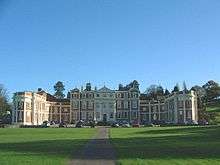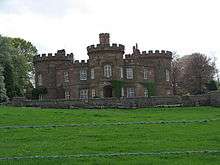Hawkstone Park
Hawkstone Park is a historic landscape park with pleasure grounds and gardens formerly belonging to Hawkstone Hall, just North East of the small village of Weston-under-Redcastle, near to Market Drayton, in Shropshire, England. It is one mile (1.6 km) east of the A49 road. The park is known for its follies.
| Hawkstone Park | |
|---|---|
Part of Hawkstone Park | |

| |
| Type | Historic landscape |
| Location | Weston-under-Redcastle, Shropshire, England |
| Nearest town | Market Drayton |
| Area | 100 acres (40.47 ha) |
| Operated by | Hawkstone Hall |
| Status | Open |
Park
Today the park consists of 100 acres (40 ha) of follies and landscaped parkland grounds and rocky outcrops, based around the ruins of the medieval Red Castle. The park was created as the gardens for Hawkstone Hall.
Hawkstone Hall itself was established by Richard Hill of Hawkstone (1655–1727), also known as 'The Great Hill', circa 1707, whilst the follies, estate and reputation were mainly established by his nephew and heir Sir Rowland Hill, 1st Baronet Hill of Hawkstone (1705–1783) and Sir Richard Hill, 2nd Baronet (1733–1808) in the 18th century.
The park then fell foul of a century of neglect and decay until an ongoing programme of restoration was started in 1990, enabling it to be re-opened in 1993. It is now scheduled as Grade-1 listed on the National Register of Historic Parks and Gardens. It takes a 2.5-hour hiking tour to completely see each folly and their landscapes (a reasonable level of physical fitness and mobility is required and there are many steps, ascents and descents). At some times of the year, not all site trails are accessible.
Attractions include a red brick tower, once lime washed and still called the White Tower, the Monument standing over 100 feet (30 m) high commemorating Sir Rowland Hill who was the first Protestant Mayor of London, the Cleft which is spanned by the Swiss Bridge, the Grotto which may have originated as a 5th-century copper mine and the Arch atop of Grotto Hill, plus various caves, tunnels through the rock, walkways, viewpoints and trails winding through Rhododendron plantations.
The Park was used to represent parts of Narnia in the BBC's TV adaptation of C. S. Lewis's books for the battlegrounds in The Lion, the Witch and the Wardrobe in 1988 and Prince Caspian a year later.
Hawkstone is currently combined with an adjacent hotel (formerly a lodge of the hall) marketed in association with the Principal Hayley Group, golf course. Hawkstone Hall, nearby, is a Catholic retreat, open to the public in August, courtesy of English Heritage roof repair funds.
History
Castle
The site of the Red Castle is closed to the public as it is unsafe. It takes up the top of Red Castle Hill (the westerly outcropping hill of the park grounds), a crag overlooking the golf course and Weston to its South East.[1]
Red Castle, the first castle at Hawkstone Park, was built in 1227 by Henry de Audley (Alditheley), Sheriff of Shropshire and Staffordshire. This Norman enclosure castle was built of sandstone on a natural outcrop of rock, flanked on all sides by wide valleys. The castle has been known by various names: Red Castle; Rubree; Radeclif, Redcliffe, Redde, Castle Rous, and Hawkstone.
About the same time (1227-1232) Henry also built Heighley Castle at Madeley, Staffordsire, and made it the family caput. Subsequent generations of Audleys were also known as, Lords of Heleigh Castle, and expanded from there.
The "Red Castle", as it became known, was held by the family until the early 16th century initially as their main Shropshire stronghold. Repairs were undertaken in 1283. It was in use in 1322, but by around 1400 it seems no longer occupied. When Leland visited the castle in around 1540 he described it as ruinous.[1]
John Tuchet, 4th Baron Audley (1371–1408) inherited the title via his sister, then survived the uprising of Owain Glyndŵr and the Battle of Shrewsbury in 1403, where he fought against Henry "Hotspur" Percy. His son James Tuchet, 5th Baron Audley (1398–1459) was killed by Sir Roger Kynaston, whilst leading the House of Lancaster at the Battle of Blore Heath in 1459.
The Audleys forfeited the title when James Tuchet, 7th Baron Audley (c. 1463–1497) led a rebellion against King Henry VII of England in 1497 and was executed. The Audley title was restored to John Tuchet, 8th Baron Audley in 1512.
Manor house

The Hall stands on the site of an earlier Manor House. The manor was purchased, together with Soulton, by Sir Rowland Hill and Thomas Leigh from Thomas Lodge in 1556, under long leases (until 1610) for the quiet enjoyment by his brother Edward Lodge.[2]
Eventually the lands passed via Sir Andrew Corbet of Moreton Corbet to Sir Rowland Hill, 1st Baronet Hill of Hawkstone (1705–1783), who lived nearby at Shelvock Manor. He was the great, great, great, grandson of Sir Rowland Hill, the first Protestant Lord Mayor of the City of London and Member of Parliament for the City of London in 1533, and who had owned Hawkstone and nearby Soulton. The manors of Hawkstone and Soulton were sold in 1556 by Thomas Lodge to Sir Rowland Hill and Thomas Leigh under long leases (until 1610) for quiet enjoyment by his brother Edward Lodge.[3]
Hall
Richard Hill (1655–1727), 'The Great Hill', traveller and diplomat, had made a fortune by 'lucrative arithmetick' (sic), raised the family into the aristocracy, and established the existing Hawkstone Manor House as the family seat, He started partial demolition of the house in 1701 replacing it with the Hall, completing it circa 1707.[4]
Sir Rowland Hill, 1st Baronet (1705–1783), landscaped the Red Castle and extended the estate, with walks over the four natural hills and a wide range of follies that included a hermit to dispense wisdom to visitors.
Sir Richard Hill, 2nd Baronet (1733–1808) took over on his father’s death in 1783, published a guide for visitors and built the 'Hawkstone Inn' to accommodate them. He engaged landscape gardener William Emes to build a vast manmade lake, the Hawk River and his follies included a 'ruined' Gothic architecture Arch on Grotto Hill, the urn, a tribute to an English Civil War ancestor, the Swiss Bridge, and the 100-foot (30 m) obelisk with an internal staircase, topped by a statue of the original Sir Rowland Hill. Hawkstone Park had become one of Britain’s top attractions by the time he died in 1808. It maintained this status under his brother Sir John Hill, 3rd Baronet (1740–1824).

Sir Rowland Hill, 4th Baronet Hill of Hawkstone, 2nd Viscount Hill (1800–1875) inherited, spent and lost a large fortune. He created two new drives, one at vast expense through a rock cutting, and even considered completely relocating the hall across the park. In 1824-5 he built a dower house known as The Citadel in Gothic Revival style. His extravagance and bad management caused a descent into a mess that was inherited by his son in 1875.
Rowland Clegg-Hill, the 3rd Viscount Hill (1833–1895) was bankrupt by the time of his death in 1895, forcing the sale of the contents of the hall and then the split up of the estate by 1906.
The hall was purchased by George Whitely, later Baron Marchamley of Hawkstone, Liberal Whip. He had extensive restoration and reconstruction done by Wm. Tomkinson and Sons of Liverpool, managed by H.P. Dallow, which included shortening in length and reducing in elevation, the wings of the house. The chapel wing was reconstructed as a games room with a dance floor, and the other wing was converted to servants accommodation.
The hall and lake became a religious retreat in the 1920s, while the hotel and a large part of the park later became a golf course. During World War II, parts of the park were used as a prisoner of war camp.
Hawkstone Park is now largely restored, and once again open to the public. It is protected as a Grade I historic park, as rated by English Heritage.
Dr. Johnson visited and wrote of...
- "its prospects, the awfulness of its shades, the horrors of its precipices, the verdure of its hollows and the loftiness of its rocks ... above is inaccessible altitude, below is horrible profundity." (1774).
Erasmus Darwin also visited, and notes the outcrops of copper-bearing rocks...
- "at Hawkstone in Shropshire, the seat of Sir Richard Hill, there is an elevated rock of siliceous sand which is coloured green with copper in many places high in the air." (1783).
Golf course
Hawkstone Park has two 18-hole golf courses, set in and around the parkland. Sandy Lyle was tutored in golf by his father Alex, who was the resident golf professional at Hawkstone.
References
- Historic England. "Red Castle: an enclosure castle in Hawkstone Park (1020850)". National Heritage List for England. Retrieved 15 October 2017.
- The National Archives, Discovery Catalogue piece description 'Bargain and sale (1556)', 215/31 (Shropshire Archives).
- The National Archives, Discovery Catalogue piece description 'Bargain and sale (1556)', 215/31 (Shropshire Archives).
- "Letters from John Hill to his brother, Hon Richard Hill". Discovering Shropshire's History. Retrieved 15 October 2017.
External links
| Wikimedia Commons has media related to Hawkstone Park. |